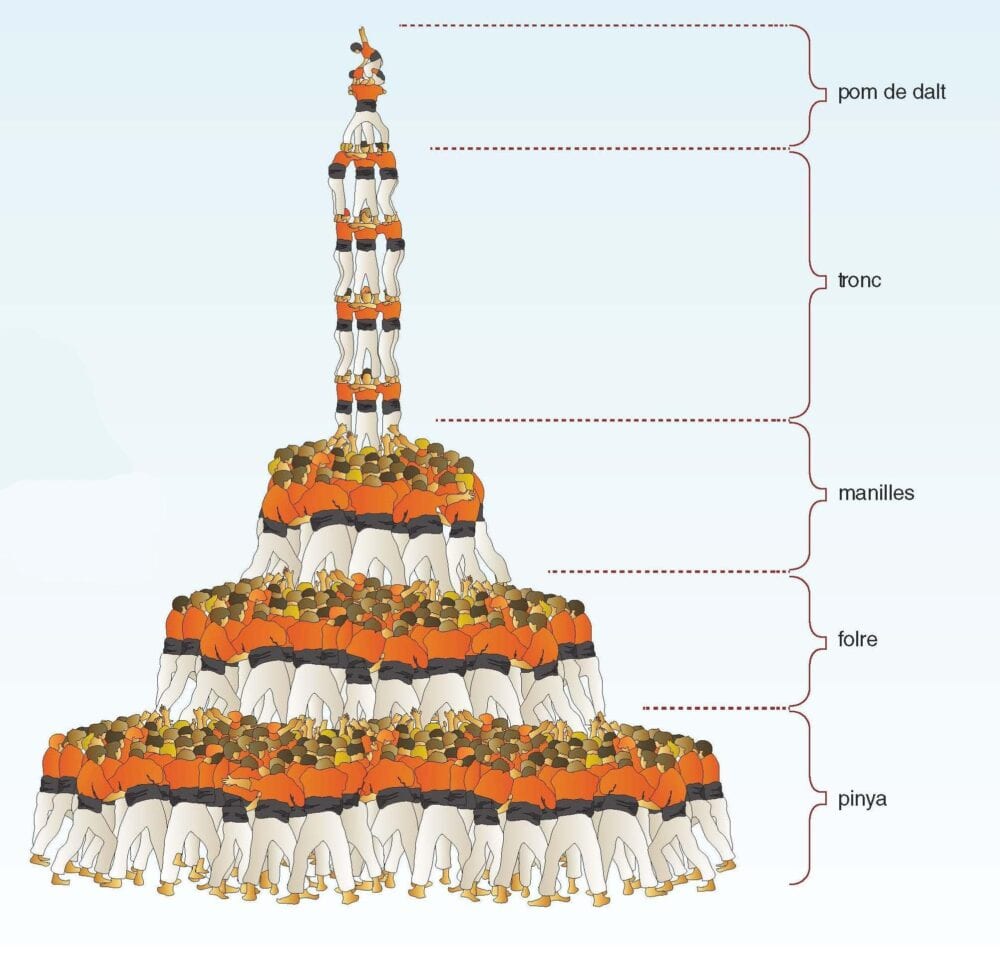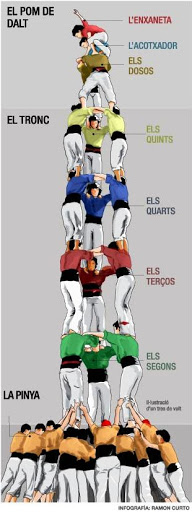WHAT ARE THE CASTELLS OR HUMAN TOWERS?
The castells or human towers are for sure the best-known Catalan tradition around the world. Nowadays it is not strange to see Castells at the top of a skyscraper in Manhattan ( video) or the “Xiquets de Hangzhou” the Chinese “Colla” participating in a competition in Tarragona (video).
Listed by the Unesco as an Intangible Cultural Heritage of Humanity by UNESCO in 2010.
We could say that “castells” are human towers erected by a group or Colla of “Castellers” formed by men and women of various ages from 9 to even 60 years old, and different complexions. They build towers by doing groups of 2,3 or 4 with their arms clasped and standing stall upon their colleague’s shoulders to reach quite a few stories of altitude.
The castells are not just a show or some kind of acrobatics, Castells is much more, it means TRADITION to the Catalans; there is evidence of their existence since the end of the 18th century.
It represents important human values such as union, trust, solidarity, and the spirit of improvement. Without any doubt, a team effort; because they need each other, everyone collaborates with a specific role and place in the Castell.
Both group and individual values are so important that today many companies motivate their employees with team-building events that include Castell’s activities or workshops, turning their employees into a “Colla de Castellers” for a few hours.
ORIGIN OF THE CASTELLS
The castells were born towards the end of the 18th century in the Tarragona area, specifically in the town of Valls, derived from the popular dance called Ball de Valencians, which ended precisely with the erection of a human tower.
Originally these Balls de Valencians were a pagan tradition, and over time they were integrated into processions and religious demonstrations.
Later on, these brotherhoods formed the “colles”, holding competitions to see who could make the highest castle, thus losing the religious sense and becoming a competitive tradition by themselves.
PARTS OF A CASTELL
The “castells” formation technique has traditionally been transmitted from generation to generation within the “colles” and is acquired through practice.
We are going to explain the different parts of a castell, but we assure you that they are complex and variable formations, since there are different types of Castells.
LA PINYA
The “Pinya” is the base of the castell the Castellers at the ground level. The number of people at the pinya varies according to the size of the colla and the castell that will be formed. If you want a tall Castel you need many people at the Pinya.
The Castellers with a stronger, more robust complexion are the baixos; the ones that are placed at the base and those that will have to bear most of the weight of the entire castell.
Some important constructions have folre, which is a second smaller pinya on top of the first one. Some of the highest castells even have a third pinya, the manilles, located above the folre. Take a detailed look at the picture. Take a close look at the picture above.
All of them work as the flying buttress on a building.
TOWER
The tower rises above the pinya.
The tower is formed by the tronc and the pom de dalt.
The Tronc is the central part of the Tower and is made up of:
Els segons (the seconds)
Els terços (the thirds)
Els quarts (the fourths)
Els quints (the fifths)
The Pom de Dalt is the upper part of the Tower, the last 3 floors; with the youngest Castellers and consists of the dosos, the Acotxador, and the Enxaneta:
- Els dosos: they are usually boys and girls from 9 to 14 years old, strong enough to support the weight of the 2 upper levels, but light and agile to climb all the way up the tower.
- The Acotxador or Aixecador: boy or girl from 5 to 10 years old, the smallest one of the entire castell so that the enxaneta can more comfortably pass over him.
- The Enxaneta: between 5 and 10 years old. The Castle is not considered loaded until the enxaneta reaches the top of the castell, places both feet on the backs of both of them, and raises his/her hand. This is the peak of construction.
MORE ABOUT CASTELLS and HUMAN TOWERS
- The groups of “Castellers” differ by their clothing, and more specifically, by the color of their shirts. The pants are usually white. They wear a wide girdle, a kind of strip that protects their back and serves as a point of support for those who climb to the tower’s upper floors. Before and after the “castell” is formed, the rhythms of the “grallas” and the tambourines accompany the formation with their music.
- The castells require weekly rehearsals and many hours of practice, effort, and concentration; there is no room for improvisation. This is a totally amateur practice: in a colla castellera nobody charges.
- Currently, there are more than 60 registered colles or groups, and 2 of the best known are la Colla Vella dels Xiquets de Valls and la Colla Joves Xiquets de Valls.
- Women were incorporated from the 80s.
- Since 2012 the 4 children of the Pom de Dalt must wear a protective helmet both in rehearsals and performances.



